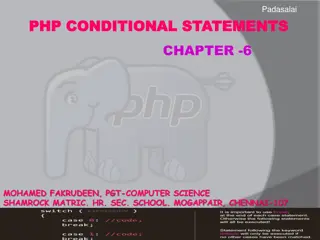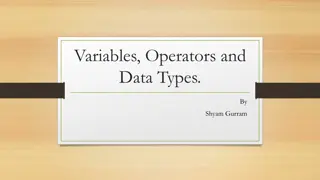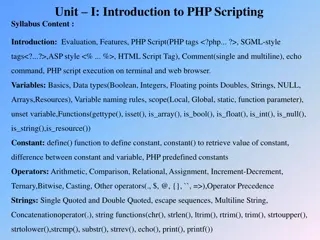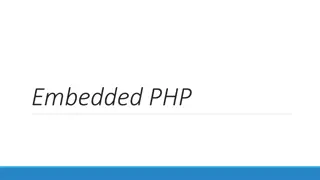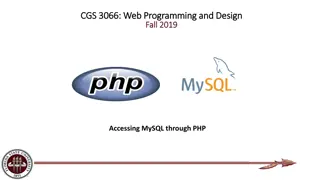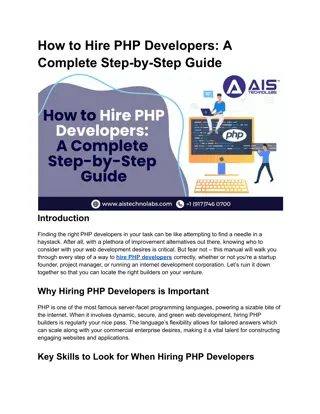
Django Web Framework Overview and Comparison
"Learn about the Django web application framework, its history, features, and why it is widely used. Compare Django with other popular web frameworks like Ruby on Rails and PHP to understand its advantages. Explore the key components and benefits of Django for developing dynamic websites and web applications."
Download Presentation

Please find below an Image/Link to download the presentation.
The content on the website is provided AS IS for your information and personal use only. It may not be sold, licensed, or shared on other websites without obtaining consent from the author. If you encounter any issues during the download, it is possible that the publisher has removed the file from their server.
You are allowed to download the files provided on this website for personal or commercial use, subject to the condition that they are used lawfully. All files are the property of their respective owners.
The content on the website is provided AS IS for your information and personal use only. It may not be sold, licensed, or shared on other websites without obtaining consent from the author.
E N D
Presentation Transcript
The Django Web Application Framework zhixiong.hong 2009.3.26
Outline Overview Architecture Modules Example Links
Outline Overview Architecture Example Modules Links
Web Application Framework Define A software framework that is designed to support the development of dynamic website, Web applications and Web services (from wikipedia) The ideal framework Clean URLs Loosely coupled components Designer-friendly templates As little code as possible Really fast development
Web Application Framework(cont..) Ruby Ruby on Rails (famous, beauty) Python Django, TurboGears, Pylons, Zope, Quixote,web2py(simple) PHP CakePHP, CodeIgniter, PRADO, ThinkPHP,QeePHP (poor performance) Others Apache, J2EE, .NET...(complex)
Web Application Framework(cont..) Comparsion
What a Django Django is a high-level Python web framework that encourages rapid development and clean, pragmatic design. Primary Focus Dynamic and database driven website Content based websites
Django History Named after famous Guitarist Django Reinhardt Developed by Adrian Holovaty & Jacob Kaplan-moss Open sourced in 2005 1.0 Version released Sep.3 2008, now 1.1 Beta
Why Use Django Lets you divide code modules into logical groups to make it flexible to change MVC design pattern (MVT) Provides auto generated web admin to ease the website administration Provides pre-packaged API for common user tasks Provides you template system to define HTML template for your web pages to avoid code duplication DRY Principle Allows you to define what URL be for a given Function Loosely Coupled Principle Allows you to separate business logic from the HTML Separation of concerns Everything is in python (schema/settings)
Outline Overview Architecture Modules Example Links
Django as an MVC Design Pattern MVT Architecture: Models Describes your data structure/database schema Views Controls what a user sees Templates How a user sees it Controller The Django Framework URL dispatcher
Architecture Diagram Brower Template URL dispatcher View Model DataBase
Model Brower Template URL dispatcher View Model DataBase
Model Overview SQL Free ORM Relations API
Model class Category(models.Model): name = models.CharField(max_length=200) slug = models.SlugField(unique=True) class Entry(models.Model): title = models.CharField(max_length=200) slug = models.SlugField(unique=True) body = models.TextField() data = models.DateTimeField(default=datetime.now) categories = models.ManyToManyField(Category) python manage.py syncdb
Model API >>> category = Category(slug='django', name='Django') >>> category.save() >>> print category.name u'Django' >>> categories = Category.objects.all() >>> categories = Category.objects.filter(slug='django') >>> categories [<Category: Category object>] >>> entry = Entry(slug='welcome', title='Welcome', body='') >>> entry.save() >>> entry.categories.add( category[0] ) >>> print entry.categories.all() [<Category: Category object>]
View Brower Template URL dispatcher View Model DataBase
View def entry_list(request): entries = Ebtry.objects.all()[:5] return render_to_response('list.html', {'entries': entries}) def entry_details(request, slug): entry = get_object_or_404(Entry, slug = slug) return render_to_response('details.html', {'entry': entry})
Template Brower Template URL dispatcher View Model DataBase
Template Syntax {{ variables }}, {% tags %}, filters (list.html) <html> <head> <title>My Blog</title> </head> <body> {% for entry in entries %} <h1>{{ entry.title|upper }}</h1> {{ entry.body }}<br/> Published {{ entry.data|date:"d F Y" }}, <a href= {{ entry.get_absolute_url }} >link</a>. {% endfor %} </body> </html>
Tag and Filter Build in Filters and Tags Custom tag and filter libraries Put logic in tags {% load comments %} <h1>{{ entry.title|upper }}</h1> {{ entry.body }}<br/> Published {{ entry.data|date:"d F Y" }}, <a href= {{ entry.get_absolute_url }} >link</a>. <h3> : </h3> {% get_comment_list for entry as comment_list %} {% for comment in comment_list %} {{ comment.content }} {% endfor %}
Template Inheritance base.html index.html <html> <head> <title> {% extend base.html %} {% block title %} Main page {% endblock %} {% block body %} Content {% endblock %} {% block title %} {% endblock %} </title> </head> <body> {% block body %} {% endblock %} </body> </html>
URL Dispatcher Brower Template URL Dispatcher View Model DataBase
URL Dispatcher urlpatterns = patterns('', #http://jianghu.leyubox.com/articles/ ((r'^articles/$', article.views.index'), ) #http://jianghu.leyubox.com/articles/2003/ (r'^articles/(?P<year>\d{4})/$', article.views.year_archive'), # http://jianghu.leyubox.com/articles/2003/ 12/ (r'^articles/(?P<year>\d{4})/(?P<month>\d{2})/$', 'article.views.month_archive'), # http://jianghu.leyubox.com/articles/2003/ 12/3 (r'^articles/(?P<year>\d{4})/(?P<month>\d{2})/(?P<day>\d+)/$', 'article..views.article_detail'), )
Outline Overview Architecture Modules Example Links
Modules Form Adminstration interface Custom Middleware Caching Signals Comments system More...
Modules:Form class ContactForm(forms.Form): subject = forms.CharField(max_length=100) message = forms.CharField(widget=forms.Textarea) sender = forms.EmailField() cc_myself = forms.BooleanField(required=False) <form action="/contact/" method="POST"> {{ form.as_table}} <input type="submit" value="Submit" /> </form>
Modules: Custom Middleware chain of processes request response Common Middleware Session Middleware Authentication Middleware Profile Middleware
Modules: Caching Memcached Database Filesystem Local-memory Dummy BaseCache template caching Per-View Caching Per-Site Caching
Modules:More... Sessions Authentication system Internationalization and localization Syndication feeds(RSS/Atom) E-mail(sending) Pagination Signals
Outline Overview Architecture Modules Example Links
Example django_admin startproject leyubbs modify setting.py set database options append admin app: django.contrib.admin python manager.py syncdb python manager.py runserver modify urls.py, append /admin path
Example(cont...) python manager.py startapp article add a model python manager.py syncdb explore admin page inset a record in adminstration interface add a veiw function add a url
Outline Overview Architecture Modules Example Links
Links: Resource http://www.djangoproject.com/ For more information (Documentation,Download and News) http://www.djangobook.com/ A Good book to learn Django http://www.djangopluggables.com A lot of Django Pluggables available online Explore at http://www.pinaxproject.com/ Community Development





